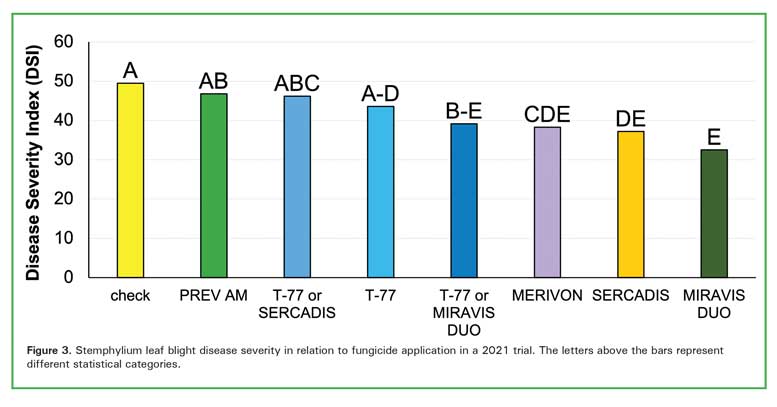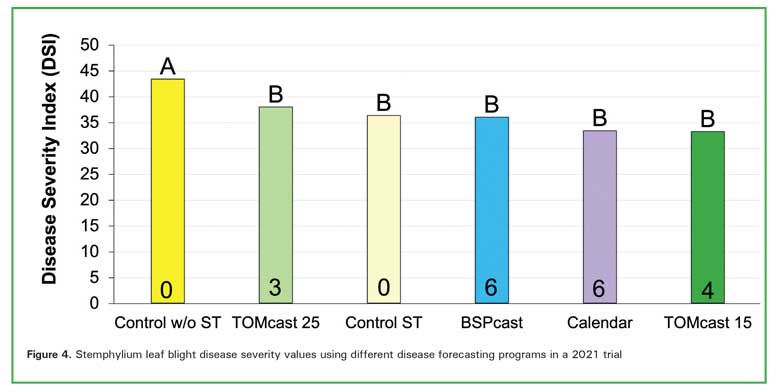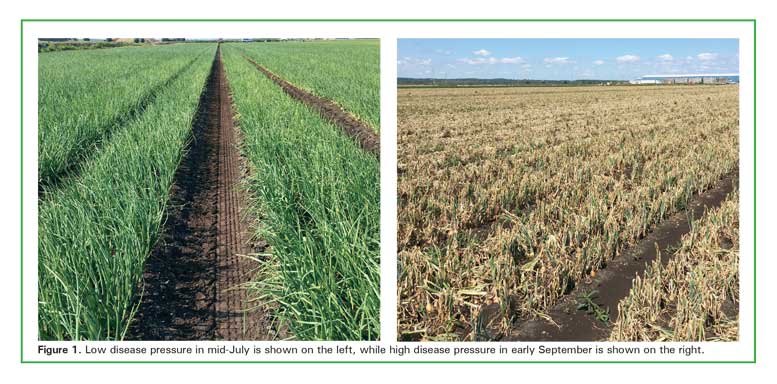|
Click to listen to this article
|
By Michael Kooy, Emily McFaul, Kevin Vander Kooi and Mary Ruth McDonald, University of Guelph
With dwindling efficacy of tools to manage Stemphylium leaf blight in onion, the search is on for new products and practices.
Stemphylium leaf blight (SLB) is an important foliar disease of onion in North America that is caused by the fungal pathogen Stemphylium vesicarium. SLB was first observed in the Holland Marsh, Ontario, Canada, in 2008 and has since become the most dominant onion disease in the Great Lakes region of North America.
In Ontario, symptom development begins at the beginning of July (3-4 leaf stage) and continues until harvest (Fig. 1). SLB lesions initially appear as yellow streaks on the lower leaves, developing into tan, water-soaked lesions (Fig. 2a). Tip dieback is common in Ontario onions (Fig. 2b), leading to premature leaf death, which can reduce the size and quality of bulbs.
Controlling SLB is critical as there are no commercial cultivars with strong resistance to the disease. Management relies on disease forecasting combined with foliar fungicides. Periods of warm (77 degrees Fahrenheit) and wet (leaf wetness period > 24 hours) weather are ideal for SLB development. Currently, there are only six fungicides registered in Ontario for SLB management in onion: Quadris Top (azoxystrobin/difenoconazole), Luna Tranquility (fluopyram/pyrimethanil), Sercadis (fluxapyroxad), Aprovia Top (benzovindiflupyr), Miravis Duo (pydiflumetofen/ difenoconazole) and Merivon (pyraclostrobin/fluxapyroxad). Most of these fungicides contain group 7 chemicals. Unfortunately, fungicide effectiveness against SLB has declined in recent years, likely because of fungicide resistance.

Fungicide Resistance
SLB is considered high risk for resistance development. Studies in New York and Michigan have demonstrated S. vesicarium resistance to multiple fungicides, including those in groups 2, 3, 7, 9 and 11. From 2015 to 2020, there were reports that fungicide applications did not reduce SLB severity relative to the untreated check.
In 2020, 30 isolates from a total of nine fields were evaluated for resistance to the active ingredients in the fungicides Quadris Top (azoxystrobin) and Luna Tranquility (fluopyram) by examining spore germination and fungal growth. The majority of isolates were resistant to both active ingredients. In all, 97 percent of isolates were resistant to azoxystrobin based on spore germination. All the isolates were resistant to fluopyram. The fungal growth assessment provided similar results with 90 percent of isolates with resistance to azoxystrobin.
This study found that fluopyram no longer prevents spores from germinating but can reduce the growth of the fungus after the spores germinate – so it may still have a small effect on SLB. Historically, Luna Tranquility (containing fluopyram) was valued as one of the most effective products for SLB management. Over time, we have seen a lack of SLB control in the field, most likely because of this resistance. There are differences between resistance to fungicides in New York and Ontario. Growers in New York, and most states, have more fungicides registered for use against S. vesicarium than in Ontario. When a grower can rotate through fungicides in different groups, it takes longer for fungicide resistance to develop.

Fungicide Efficacy
In 2021, a field trial was conducted to evaluate fungicides for SLB management. Small trial plots were sprayed on four dates, starting June 30. Products used were T-77 (Trichoderma atroviride), Prev Am (orange oil), Miravis Duo (pydiflumetofen/ difenoconazole), Sercadis (fluxapyroxad), Merivon (pyraclostrobin/fluxapyroxad),
T-77 alternated with Miravis Duo, and T-77 alternated with Sercadis. An untreated check was included. Just before lodging, 20 plants from each treatment were removed and percent leaf dieback evaluated to calculate disease severity (DSI).
Stemphylium incidence was moderate in 2021 and increased through July. Onions treated with Miravis Duo, Sercadis, Merivon, or Miravis Duo alternated with T-77 had lower SLB severity compared to the untreated check (Fig. 3). The differences between the treatments were small. However, there were differences in yield. Onions treated with Miravis Duo or Sercadis alone or alternated with T-77 had significantly higher yield compared to the untreated check. This study indicates that the biological product T-77 does not provide adequate disease control on its own but could be very useful when alternated with an effective fungicide.

Disease Forecasting
In the Holland Marsh, foliar fungicide applications begin when the disease is first reported or when the pest management program indicates a high risk of disease. Recent studies suggest that the current disease forecasting systems trigger too many sprays.
In a previous study, two spray timing models were evaluated. Both BSPcast and TOMcast models use temperature and leaf wetness duration to guide spray timings. BSPcast is designed for brown spot (Stemphylium vesicarium) of pear and recommends optimal spray timings based on a three-day cumulative risk factor. TOMcast was designed for anthracnose (Glomerella cingulata) and septoria leaf spot (Septoria lycopersici)of tomatoes. A disease severity value (DSV) is calculated each day and sprays are recommended when cumulative DSVs reach a defined threshold. In this case, the thresholds were 15 and 25 DSVs.
A spray timing trial was performed in 2021 in the Holland Marsh to compare the TOMcast and BSPcast models. The treatments were TOMcast with a threshold of 15 or 25, BSPcast and a calendar-based spray program (7-10-day interval starting at the 4 true leaf stage). There were two untreated checks, one with Evergol Prime (penflufen) seed treatment and one without any form of seed treatment. Evergol Prime is registered for the control of onion smut but has shown effectiveness against SLB in recent years. All models used fungicides Miravis Duo (pydiflumetofen/ difenoconazole) and Dithane (mancozeb) in rotation. As in the fungicide trial, a disease severity index (DSI) was calculated by evaluating percent leaf dieback.
All disease forecasting models reduced disease severity in the final assessment compared to the control without seed treatment (Fig. 4). The differences in disease reduction between treatments were relatively small, demonstrating that the models triggered more fungicide sprays than needed. The calendar program recommended six sprays, TOMcast (threshold of 15) recommended four sprays, TOMcast (threshold of 25) recommended three sprays, and BSPcast recommended six sprays. There were no differences in yield among the treatments (53-63 t/ha).
Conclusions
An integrated management approach is recommended as the best way to control SLB. The loss of effective fungicides for management of this disease in Ontario from 2012 and 2020 has been rapid and is expected to continue. Therefore, new modes of action, more effective disease forecasting and alternative methods for management of SLB are needed to maintain onion quality and yield. Other sustainable disease management methods are being explored, including identifying less susceptible varieties, the role of toxins in SLB development, alternative fungicide treatments and identifying overwintering hosts of the pathogen.

